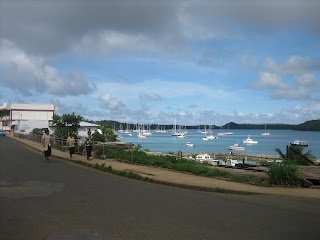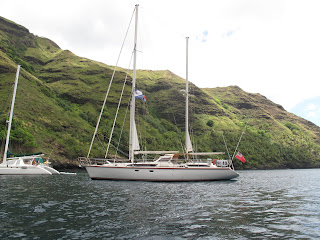June 5 – arrived Neiafu 1100 hours local time. The MaxSea electronic charts were fine till we were near the entrance of Neiafu harbor. We’d been warned that most electronic charts contained errors at the approach. We were able to see the red and green buoys marking the harbor entrance and the green turning buoy beyond them. Eyeballing the course into the harbor posed no problem and we headed to the Fisheries wharf for our Health, Immigration and Customs clearances, which had been arranged by the rally organizers.
Landfall in Vavau
Yacht anchorage, Neiafu
After clearance, it was a short distance to the moorings provided by Beluga Diving. We picked one up quite close to the dinghy dock and went ashore to look around. Activity in the town of Neiafu is centered on the road along the shoreline. There are 2 banks there – ANZ and MBF (whose logo looked familiar to that of the Malaysian financial services company of the same name). There are a few stores selling provisions and a fresh market which seemed to focus on Kava.
Main Street, Neiafu
The Catholic church was a prominent landmark perched on high ground and could be seen when approaching the harbor. The next day was Sunday and I went to the 10 am mass during which the choir put on quite a performance. It was like a concert of Polynesian music. The church was full of Tongans as well as visiting yachties, most of whom were non-Catholic, judging from who went forward to receive communion. The Tongans came in their Sunday best, men and women wearing ornamental woven straw (from some kind of pandanus plant) mats and belts.
Sunday at the Catholic church
Monday June 7 -- Francois left Skylark to join his wife and friends on a Moorings catamaran they had chartered for a week. Ed and I explore Neiafu and its surroundings mostly on foot and do some boat maintenance. We went out to the open sea a couple of times for an afternoon's sail and to empty holding tanks and run the water maker. On Friday June 11, we took a private tour of the island -- by a friendly Tongan named Sam whose taxi service was called Road Runner, after the cartoon character. Sam's wife is German and he is well traveled, sophisticated and has a rock band that some times has gigs as far away as Tongatapu. He told us from the outset that Vavau didn't have nuch by way sights (other than its beautiful islands) but that the history and contemporary social and political environment should be of more interest to us. It was a tour tailor-made for Ed and I as those were areas we were always interested in when we visited a new place. At least from Sam's perspective, there was some rot in the system and a lack of enterprise among the Tongans. He seemed to imply that the men went to work each day in the bush -- but really to sleep off the effects of too much Kava the night before. The women on the other hand worked at weaving and other crafts and the market and stores. That seemed to fit with our fleeting observations of life in Neiafu. The current members of royalty seldom set foot in Vavau, preferring the amenities of Tongatapu and displayed little of the noblesse oblige of the former king. Along the way, Sam took us to visit with his two horses and his friends water melon patch, as well as some scenic spots from which to view the coast line. We stopped at a Kava grinding shop where the dried root was ground into a fine powder by electric prowered grinding machines. Sam also pointed out the Neiafu prison - an open compound which quarters for prison staff and housing for the "prisoners" They were free to go out each morning to work the fields and the prison gates were always open. Sam said the prisoners were mostly in there for fighting when drunk and that there was no risk of flight -- where would they go on this island where every one knew every one...?
the Neiafu jail....
Sam, the Road Runner took us off-roading, sort of (on the way to meet his horses)
the rugged coast line of Vavau
Francois came back to the boat with his wife on Monday, June 14. We planned to leave Neiafu on Tuesday, June 15 and made arrangements for diesel to be delivered by tank truck at the wharf at 1 pm that day. Immigration formalities were completed the day before but Customs clearance could only be done oin the day of departure. All was done by 2 pm, June 15 and we left the wharf and headed out of the harbor and set course for Fiji. Strong winds and rough seas were predicted but they were all within Skylark's limits. The breeeze freshened a few hours later and the waves got gradually to thje predicted 3.5 to 4 meters, making for a rather bouncy passage. The wind was sustained near 30 knots and gusted frequently to 40 - 42 knots. The genoa pole was taken in because of the rough conditions and I did not want to risk damage to our rig. Francois' wife was sea sick and retired to their cabin for the next two days. On the third day, as we approached Suva, the wind settled to around 20 knots and seas were a lot calmer. Fiji will be the topic of the next post.

























































